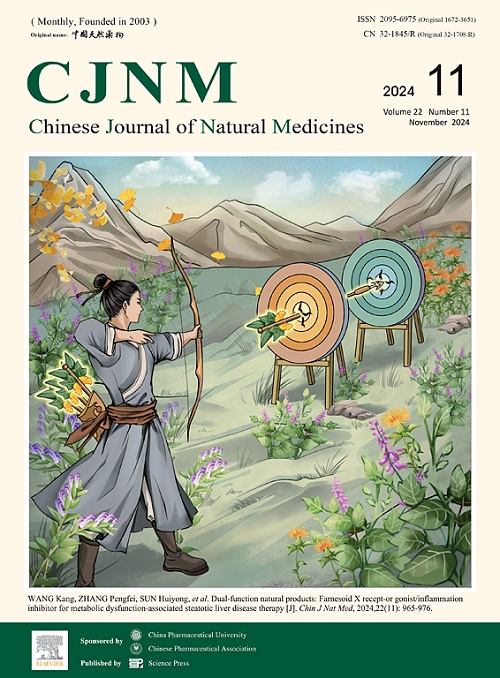在体外和体内研究中,短回芽素苷通过与TLR4结合对急性肺损伤有治疗作用
IF 4.9
2区 医学
Q1 INTEGRATIVE & COMPLEMENTARY MEDICINE
引用次数: 0
摘要
急性肺损伤(ALI)是一种由病毒感染引起的严重疾病,可引发不受控制的炎症反应。本研究探讨了天然化合物茉莉素苷(JO)与toll样受体4 (TLR4)结合治疗ALI的能力。通过Western blotting、酶联免疫吸附试验(ELISA)、免疫荧光染色和共免疫沉淀等方法评价JO的体外抗炎特性。本研究采用脂多糖(LPS)诱导的ALI动物模型,在体内研究JO的治疗效果和机制。JO通过调节nod样受体家族pyrin结构域蛋白3 (NLRP3)炎性体和核因子κB (NF-κB)/丝裂原活化蛋白激酶(MAPK)通路,减轻感染细胞和组织的炎症症状。分子对接模拟显示JO与TLR4活性位点结合,细胞热移实验证实了这一点。表面等离子体共振(SPR)表明JO与TLR4之间存在直接相互作用,Kd值为35.1 μmol·L-1。此外,JO还能抑制ali小鼠肿瘤坏死因子α (TNF-α)、白细胞介素-1β (IL-1β)和IL-6的分泌,减少白细胞、中性粒细胞、淋巴细胞和巨噬细胞的浸润。JO还能增强肺功能,降低与急性呼吸道感染相关的死亡率。免疫组化染色显示JO能够抑制ali小鼠肺组织中TLR4的表达。本研究证实JO可与TLR4结合有效治疗ALI,提示其作为一种治疗药物具有临床应用潜力。本文章由计算机程序翻译,如有差异,请以英文原文为准。
Jasurolignoside from Ilex pubescens exerts a therapeutic effect on acute lung injury in vitro and in vivo by binding to TLR4
Acute lung injury (ALI) is a severe disease caused by viral infection that triggers an uncontrolled inflammatory response. This study investigated the capacity of jasurolignoside (JO), a natural compound, to bind to Toll-like receptor 4 (TLR4) and treat ALI. The anti-inflammatory properties of JO were evaluated in vitro through Western blotting, enzyme-linked immunosorbent assay (ELISA), immunofluorescence staining, and co-immunoprecipitation. The investigation utilized a lipopolysaccharide (LPS)-induced ALI animal model to examine the therapeutic efficacy and mechanism of JO in vivo. JO attenuated inflammatory symptoms in infected cells and tissues by modulating the NOD-like receptor family pyrin domain containing protein 3 (NLRP3) inflammasome and the nuclear factor κB (NF-κB)/mitogen-activated protein kinase (MAPK) pathway. Molecular docking simulations revealed JO binding to TLR4 active sites, confirmed by cellular thermal shift assay. Surface plasmon resonance (SPR) demonstrated direct interaction between JO and TLR4 with a Kd value of 35.1 μmol·L–1. Moreover, JO inhibited tumor necrosis factor α (TNF-α), interleukin-1β (IL-1β), and IL-6 secretion and reduced leukocyte, neutrophil, lymphocyte, and macrophage infiltration in ALI-affected mice. JO also enhanced lung function and reduced ALI-related mortality. Immunohistochemical staining demonstrated JO’s ability to suppress TLR4 expression in ALI-affected mouse lung tissue. This study establishes that JO can bind to TLR4 and effectively treat ALI, indicating its potential as a therapeutic agent for clinical applications.
求助全文
通过发布文献求助,成功后即可免费获取论文全文。
去求助
来源期刊

Chinese Journal of Natural Medicines
INTEGRATIVE & COMPLEMENTARY MEDICINE-PHARMACOLOGY & PHARMACY
CiteScore
7.50
自引率
4.30%
发文量
2235
期刊介绍:
The Chinese Journal of Natural Medicines (CJNM), founded and sponsored in May 2003 by China Pharmaceutical University and the Chinese Pharmaceutical Association, is devoted to communication among pharmaceutical and medical scientists interested in the advancement of Traditional Chinese Medicines (TCM). CJNM publishes articles relating to a broad spectrum of bioactive natural products, leading compounds and medicines derived from Traditional Chinese Medicines (TCM).
Topics covered by the journal are: Resources of Traditional Chinese Medicines; Interaction and complexity of prescription; Natural Products Chemistry (including structure modification, semi-and total synthesis, bio-transformation); Pharmacology of natural products and prescription (including pharmacokinetics and toxicology); Pharmaceutics and Analytical Methods of natural products.
 求助内容:
求助内容: 应助结果提醒方式:
应助结果提醒方式:


